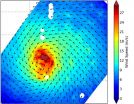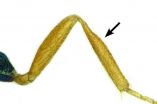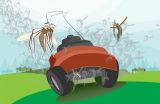(Press-News.org) BEER-SHEVA, Israel...July 22, 2015 - Ben-Gurion University of the Negev (BGU) and University of Colorado researchers have developed a dynamic "smart" drug that targets inflammation in a site-specific manner and could enhance the body's natural ability to fight infection and reduce side effects.
The uniqueness of this novel anti-inflammatory molecule, reported in the current issue of Journal of Immunology, can be found in a singular property. When injected, it is as a non-active drug. However, a localized site with excessive inflammation will activate it. Most other anti-inflammatory agents effectively inhibit inflammatory processes, though in a non-specific manner and in areas that include sites of necessary normal inflammatory homeostasis.
"This development is important because inhibition of inflammation in a non-specific manner reduces the natural ability to fight infections and is a common side effect of anti-inflammatory biologic therapeutics," says Dr. Peleg Rider of BGU's Department of Clinical Biochemistry and Pharmacology.
When a non-specific agent is used, any patient who suffers from local inflammation might then be exposed to opportunistic infections at distant sites, such as lungs, risking, for example, tuberculosis. This risk is mainly of concern to immunosuppressed patients, as well as older patients and patients undergoing chemotherapy as part of an anti-cancer treatment course.
"The beauty of this invention lies in the use of a known natural biological code," Dr. Rider explains. "We mimicked a natural process that occurs during inflammation."
The protein molecule is actually a chimera comprised of two domains, both originating from the potent inflammatory cytokine family of IL-1. The first part of the protein holds the functional part of the molecule inactive, as occurs in normal living cells, and is connected to a potent natural inhibitor of IL-1. When it encounters inflammatory enzymes, the molecule is cleaved and the functional part becomes active.
Dr. Rider, along with BGU's Dr. Eli Lewis and Prof. Charles Dinarello of the University of Colorado, demonstrated their findings in a mouse model of local inflammation. They showed that leukocytes, which infiltrate inflammatory sites, indeed activate the chimeric protein, which in turn reduces local inflammation. The activation of the protein correlated with the amount of inflammatory stimuli.
"Thus, a point that is highly relevant to clinical practice arises. Upon resolution of inflammation, the activation of the protein is also reduced and side effects are avoided," Dr. Rider explains.
INFORMATION:
The new chimeric molecule was patented by BGN Technologies, BGU's technology transfer company, and by the University of Colorado.
The research was supported by the Kamin program of Israel's Ministry of Economy's Chief Scientist's Office.
About American Associates, Ben-Gurion University of the Negev
American Associates, Ben-Gurion University of the Negev (AABGU) plays a vital role in sustaining David Ben-Gurion's vision, creating a world-class institution of education and research in the Israeli desert, nurturing the Negev community and sharing the University's expertise locally and around the globe. With some 20,000 students on campuses in Beer-Sheva, Sede Boqer and Eilat in Israel's southern desert, BGU is a university with a conscience, where the highest academic standards are integrated with community involvement, committed to sustainable development of the Negev. AABGU is headquartered in Manhattan and has nine regional offices throughout the U.S. For more information, please visit http://www.aabgu.org.
Edward Snowden's leak of classified documents to journalists around the world about massive government surveillance programs and threats to personal privacy ultimately resulted in a Pulitzer Prize for public service.
Though Snowden had no intention of hiding his identity, the disclosures also raised new questions about how effectively news organizations can protect anonymous sources and sensitive information in an era of constant data collection and tracking.
A new study by University of Washington and Columbia University researchers that will be presented next month ...
Amsterdam, The Netherlands, July 22, 2015 - In a large population-based study of randomly selected participants in Germany, researchers found that mild cognitive impairment (MCI) occurred significantly more often in individuals diagnosed with a lower ankle brachial index (ABI), which is a marker of generalized atherosclerosis and thus cumulative exposure to cardiovascular risk factors during lifetime. Interestingly, this strong association was only observed in patients with non-amnestic MCI, but not amnestic MCI. There also was no independent association of MCI and intima ...
Typhoon Halola's strongest typhoon-force winds were located on the northern half of the storm, as identified from the RapidScat instrument that flies aboard the International Space Station.
RapidScat gathered surface wind data on the Typhoon Halola on July 21at 2 p.m. GMT (10 a.m. EDT). RapidScat data showed that the strongest sustained winds stretched from northwest to northeast of the center at speeds up to 30 meters per second (108 kph/67 mph). Strong winds wrapped around the center of circulation from northwest to east to the southern quadrant, while the weakest winds ...
Much to his own surprise, Hannes Baur from the Natural History Museum Bern not only reports on whole two new parasitoid wasps at the heart of Europe, the Swiss Alps and Swiss Central Plateau. While the common discovery usually involves cryptic, or "camouflaging" within their groups species, his stand out. Baur's work is published in the open-access journal ZooKeys.
The insects he describes are visibly quite unique with their body structures. In the case of the Pteromalus briani wasp, its extraordinarily protruding hind legs differentiate it among the whole family. Meanwhile, ...
CHAMPAIGN, Ill. -- A study of the West Nile virus risk associated with "dry" water-detention basins in Central Illinois took an unexpected turn when land managers started mowing the basins. The mowing of wetland plants in basins that failed to drain properly led to a boom in populations of Culex pipiens mosquitoes, which can carry and transmit the deadly virus, researchers report.
A paper describing their findings is in press in the journal Ecological Applications.
The team, led by University of Illinois postdoctoral researcher Andrew Mackay, found that mowing down cattails ...
GeoSpace
Warmer air, less sea ice lead to mercury decline in Arctic Ocean
The amount of mercury in the Arctic Ocean is declining as the region rapidly warms and loses sea ice, according to a new study. A new study in Geophysical Research Letters suggests that fish, marine mammals, polar bears, whales and humans in the Arctic might potentially be consuming lower amounts of toxic methylmercury as the region warms.
Eos.org
Puzzles invite you to explore Earth with interactive imagery
The EarthQuiz challenge can take you to virtual field locations with just the click of ...
The Mississippi River delta is a rich ecosystem of barrier islands, estuaries, and wetlands that's home to a diverse mix of wildlife -- as well as more than 2 million people. Over the past few decades, the shape of the delta has changed significantly, as ocean waves have carved away at the coastline, submerging and shrinking habitats.
To keep flooding at bay, engineers have erected dams and levees along the river. However, it's unclear how such protective measures will affect the shape of the river delta, and its communities, over time.
Now researchers from MIT and ...
MELBOURNE, FLA. -- The coral reefs that have protected Pacific Islanders from storm waves for thousands of years could grow rapidly enough to keep up with escalating sea levels if ocean temperatures do not rise too quickly, according to a new study from Florida Institute of Technology.
The study, published Wednesday in the journal Royal Society Open Science, provides the first evidence that well-managed reefs will be able to keep up with sea-level rise through vertical growth. But that can happen only if carbon dioxide levels in the atmosphere stay below 670 parts-per ...
PITTSBURGH, July 22, 2015 - Late- and post-menopausal women have significantly greater volumes of fat around their hearts - a risk factor for heart disease - than their pre-menopausal counterparts, a University of Pittsburgh Graduate School of Public Health study has shown for the first time.
The finding, published online and scheduled for the Sept. 1 issue of The Journal of Clinical Endocrinology & Metabolism, likely can be attributed to changing hormone levels and could guide potentially life-saving interventions. The work was funded by the National Institutes of Health ...
Electronic cigarettes or "e-cigs" have been touted as a tool smokers can use to wean themselves off of traditional cigarettes, which many believe are more harmful than their "e" counterparts. But because e-cig liquid also contains nicotine and emits carcinogens, is that perception really true? One team now reports in the ACS journal Chemical Research in Toxicology that much of the nicotine in e-cigarettes is the addictive form of the compound.
Although e-cigs don't burn tobacco, they heat and vaporize a liquid that contains nicotine, flavorings and other substances. ...



